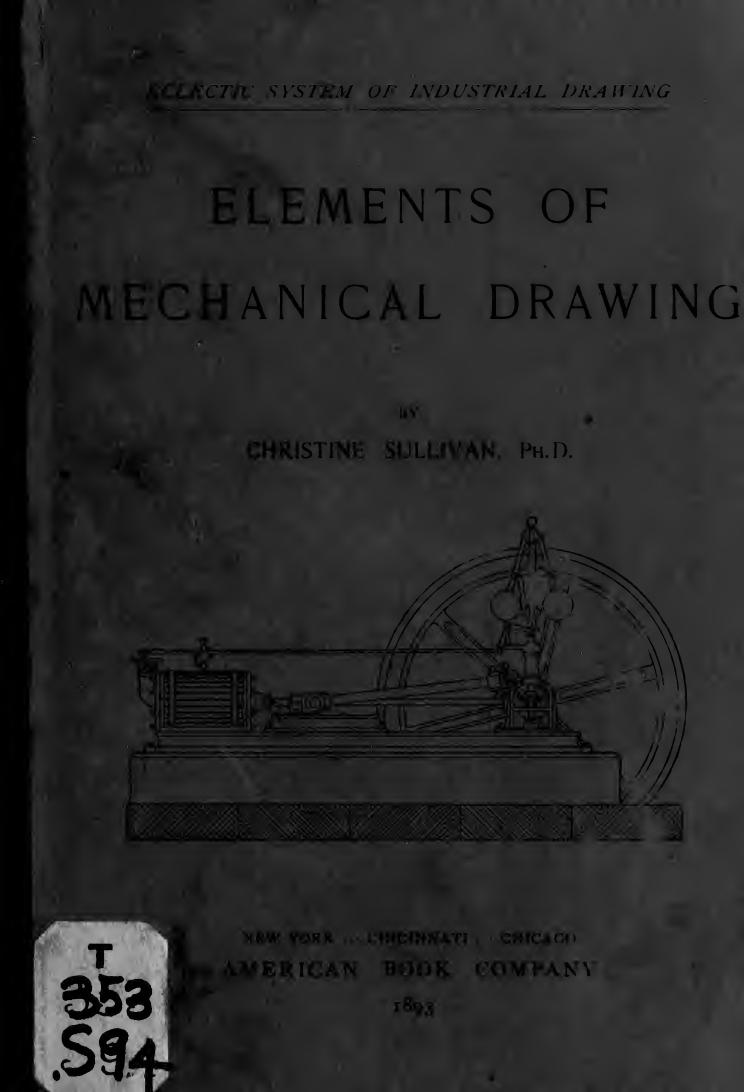Elements of mechanical drawing by Sullivan Christine

Author:Sullivan, Christine [Gordon]. [from old catalog]
Language: eng
Format: epub, pdf
Tags: Mechanical drawing
Publisher: New York, Cincinnati [etc.] American book company
Published: 1893-03-25T05:00:00+00:00
SUGGESTIONS.
1. A cube is the type form for rectilinear objects.
2. A cylinder is the type form for curvilinear objects.
3. Appearances of objects depend on two conditions,— distance and position. Distance produces perspective ; position, fore-shortening.
4. Rectilinear objects in parallel perspective have one face represented by an actual drawing, and one vanishing point.
5. In ajigular perspective no face is represented by an actual view, and there are two vanishing points.
6. The circle, w^hen in full view, is represented by a circle ; when viewed obliquely, by an ellipse ; and when viewed edgewise, by a line.
7. The point of station where the observer stands is the base of an upright plane, which the observer is supposed to occupy. All objects below his eye are said to be below the level of the eye ; all above, above the level of the eye.
8. Vertical lines are always represented by vertical lines.
9. Horizontal lines or edges are represented by horizontal and oblique lines, — by horizontal lines when the edges are parallel to the plane of the observer ; by oblique lines when the edges make an angle with this plane.
10. Retreating lines above the eye seem to run down to a point on a level with the eye, and opposite to it ; those below the eye seem to run up to the same point.
11. The apparent width of foreshortened surface may be ascertained by pencil measuring in space, and the drawing tested by rules of perspective.
12. Lines that are at an angle to the observer, and parallel in the object, vanish to one point in the drawing.
Exercise for Practice. —Make perspective sketches of cube, prisms, cylinder, cone, and pyramids.
Note i. — "Make three drawings of each object : first view, directly in front of the observer ; second view, to the left ; and third view, to the right.
Note 2. — See " Elements of Perspective for Schoolroom and Workshop."
Download
Elements of mechanical drawing by Sullivan Christine.pdf
This site does not store any files on its server. We only index and link to content provided by other sites. Please contact the content providers to delete copyright contents if any and email us, we'll remove relevant links or contents immediately.
Whiskies Galore by Ian Buxton(41741)
Introduction to Aircraft Design (Cambridge Aerospace Series) by John P. Fielding(33032)
Rewire Your Anxious Brain by Catherine M. Pittman(18502)
Craft Beer for the Homebrewer by Michael Agnew(18097)
Cat's cradle by Kurt Vonnegut(15125)
Sapiens: A Brief History of Humankind by Yuval Noah Harari(14180)
Leonardo da Vinci by Walter Isaacson(13124)
The Tidewater Tales by John Barth(12591)
Thinking, Fast and Slow by Kahneman Daniel(12001)
Underground: A Human History of the Worlds Beneath Our Feet by Will Hunt(11992)
The Radium Girls by Kate Moore(11885)
The Art of Thinking Clearly by Rolf Dobelli(10161)
A Journey Through Charms and Defence Against the Dark Arts (Harry Potter: A Journey Throughâ¦) by Pottermore Publishing(9182)
Mindhunter: Inside the FBI's Elite Serial Crime Unit by John E. Douglas & Mark Olshaker(9124)
Tools of Titans by Timothy Ferriss(8175)
Turbulence by E. J. Noyes(7911)
Wonder by R. J. Palacio(7893)
Change Your Questions, Change Your Life by Marilee Adams(7583)
Nudge - Improving Decisions about Health, Wealth, and Happiness by Thaler Sunstein(7484)
